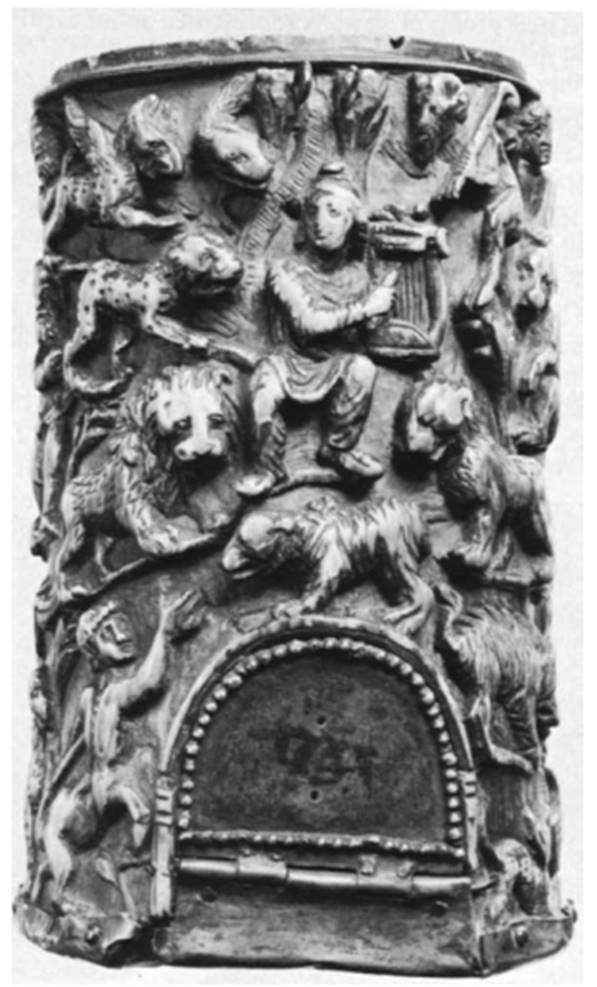Pyxis with Orpheus and hunt scenes. Eastern Mediterranean or Italy, 5th-6th century. Ivory
Without its lid, this tall, narrow, and slightly curved pyxis is perforated on its front by a semicircular opening. This is closed by a beaded metal tab hinged to a metal floor tacked onto the pyxis. Like the related pyxis in Bobbio (Volbach, 1976, no. 91), it probably served as an incense burner.
Orpheus is seated and dressed in a short tunic, Phrygian cap, and boots. He plays the lyre, ambiguously suspended in midair, with a large plec- tron in his right hand. Gathered around him are semihuman, wild, and fantastic animals with expressions ranging from curiosity to interest, attesting to the pacifying quality of Orpheus' divine gifts—the lyre, given by Apollo, and the music, taught by the muses. Around the rest of the pyxis are hunt scenes: three men mounted on horses and one on foot, all accompanied by dogs; the prey is a mixed group of lions, leopards, deer, and other, smaller animals (cf. no. 76).

The combination of Orpheus and hunt scenes may be a natural outgrowth of the presence of wild animals in both, and secondarily an allusion to man's predominance over the animal kingdom, both culturally—through music—and physically —through mastery of weapons.
However, since the discovery of Christian catacomb frescoes with Orpheus in the seventeenth century, most late Roman images of him have been subject to crypto-Christian interpretations (Hus- kinson, 1974, pp. 68-73): Orpheus, like the Good Shepherd, is an allusion to Christ as an instrument of man's liberation from his wild nature; and, specifically, the image of Orpheus among both wild and tamed animals prefigures a paradisiacal salvation, emanating from Judaic imagery (Stern, 1974, p. 15). The pyxis, however, although possibly a cult implement, still eludes specific religious connections. It might best be placed in relationship to the Bellerophon ivory (no. 143), reflecting a poetic, intellectual ambience rather than a strictly religious one.
Orpheus floats on a spare groundline in an undefined space, much as mosaics show him. Usually considered a Western work of the fifth century, the ivory's heads and drapery resemble the Wiesbaden pyxis (no. 170). The animals and the density of the figures recall the two pierced Orpheus groups in Athens and Sabratha (Bonacasa, 1960, pp. 179-184, pi. 57, figs. 2, 3), which can be associated with the Bobbio pyxis by the presence of a monkey on the lyre. All of these works may share an Eastern provenance. Bibliography: Volbach, 1976, no. 92.
Date added: 2025-08-31; views: 79;
